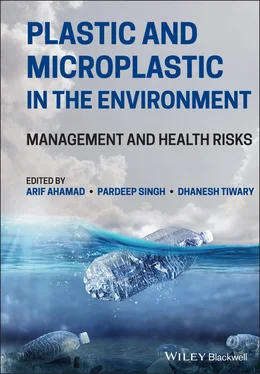Plastic and Microplastic in the Environment
Здесь есть возможность читать онлайн «Plastic and Microplastic in the Environment» — ознакомительный отрывок электронной книги совершенно бесплатно, а после прочтения отрывка купить полную версию. В некоторых случаях можно слушать аудио, скачать через торрент в формате fb2 и присутствует краткое содержание. Жанр: unrecognised, на английском языке. Описание произведения, (предисловие) а так же отзывы посетителей доступны на портале библиотеки ЛибКат.
- Название:Plastic and Microplastic in the Environment
- Автор:
- Жанр:
- Год:неизвестен
- ISBN:нет данных
- Рейтинг книги:5 / 5. Голосов: 1
-
Избранное:Добавить в избранное
- Отзывы:
-
Ваша оценка:
- 100
- 1
- 2
- 3
- 4
- 5
Plastic and Microplastic in the Environment: краткое содержание, описание и аннотация
Предлагаем к чтению аннотацию, описание, краткое содержание или предисловие (зависит от того, что написал сам автор книги «Plastic and Microplastic in the Environment»). Если вы не нашли необходимую информацию о книге — напишите в комментариях, мы постараемся отыскать её.
Thought-provoking discussions of the challenges posed by—and potential solutions to—plastic and microplastic pollution Plastic and Microplastic in the Environment: Management and Health Risks,
Plastic and Microplastic in the Environment
Plastic and Microplastic in the Environment: Management and Health Risks
Plastic and Microplastic in the Environment — читать онлайн ознакомительный отрывок
Ниже представлен текст книги, разбитый по страницам. Система сохранения места последней прочитанной страницы, позволяет с удобством читать онлайн бесплатно книгу «Plastic and Microplastic in the Environment», без необходимости каждый раз заново искать на чём Вы остановились. Поставьте закладку, и сможете в любой момент перейти на страницу, на которой закончили чтение.
Интервал:
Закладка:
Sumi HandiqueDepartment of Environmental Science Tezpur University Tezpur, Assam India
Sumbul JahanDepartment of Biotechnology Vinoba Bhave University Hazaribag, Jharkhand India
Rabindra KumarCentral Instrumentation Laboratory Central University of Punjab Bathinda India
Rakesh KumarDepartment of Environmental Sciences University of Jammu Jammu India
Sushil KumarDepartment of Chemical Engineering Motilal Nehru National Institute of Technology (MNNIT) Allahabad, Prayagraj UP India
Sophayo MahongnaoDepartment of Biochemistry Daulat Ram College University of Delhi New Delhi India
Carolina Martínez‐SalvadorTechnische Universität Desdren Dresden Germany
Ankitendran MishraDepartment of Metallurgical Engineering IIT Banaras Hindu University Varanasi India
Sarita NandaDepartment of Biochemistry Daulat Ram College University of Delhi New Delhi India
Sara Ojeda‐BenítezUniversidad Autónoma de Baja California Mexicali Baja California Mexico
Ankita OjhaDepartment of Chemistry Maharaja College Arrah, Bihar India
Beatriz Pérez‐AragónUniversidad Autónoma Metropolitana Mexico City Mexico
Abhay PuniaDepartment of Zoology Guru Nanak Dev University Amritsar, Punjab India
Sanchayita RajkhowaDepartment of Chemistry Jorhat Institute of Science and Technology Jorhat, Assam India
Akanksha RajputDepartment of Environmental Sciences University of Jammu Jammu India
Sumeer RazdanCentral Instrumentation Laboratory Central University of Punjab Bathinda India
Jyotirmoy SarmaDepartment of Chemistry Assam Kaziranga University Jorhat, Assam India
Steplinpaulselvin SelvinsimpsonSchool of Environmental Science and Engineering Huazhong University of Science and Technology Wuhan China
Soha ShabakaHydrobiology Lab Department of Marine Environment National Institute of Oceanography and Fisheries (NIOF) Cairo Egypt
Pooja SharmaDepartment of Biochemistry Daulat Ram College University of Delhi New Delhi India
Dharm PalDepartment of Chemical Engineering National Institute of Technology Raipur India
Nalini Singh ChauhanDepartment of Zoology Kanya Maha Vidyalya Jalandhar, Punjab India
Richa SinghInstitute of Environment and Sustainable Development Banaras Hindu University Varanasi, Uttar Pradesh India
Anh Tuan TaSchool of Biochemical Engineering and Technology Sirindhorn International Institute of Technology Thammasat University Pathum Thani Thailand
Jocelyn Tapia‐FuentesUniversidad Autónoma Metropolitana Mexico City Mexico
Dhanesh TiwaryDepartment of Chemistry IIT Banaras Hindu University Varanasi India
Hasan UsluFood Engineering Department Engineering Faculty Niğde Ömer Halisdemir University Niğde Turkey
Alethia Vázquez‐MorillasUniversidad Autónoma Metropolitana Mexico City Mexico
Kailas L. WasewarAdvance Separation and Analytical Laboratory (ASAL) Department of Chemical Engineering Visvesvaraya National Institute of Technology (VNIT) Nagpur, Maharashtra India
Preface
Humans have modified the environment to better answer their needs, and in the process, they have changed the homeostatic mechanisms of the earth's system. The ecological fabric of the planet has undergone drastic changes due to human‐induced modifications. These changes have resulted in certain thresholds of ecological systems being broken. One such human activity is the production of waste, mainly plastic waste. Plastics are a versatile material that provides an inexpensive alternative to many industries. Plastics are a group of synthetic polymers which are now considered as an indicator of the Anthropocene. Of the 300 million tons of plastic produced each year on average, 50% of waste is designed for waste applications, i.e., it is destined to be thrown away. The European Union alone accounts for about 650 thousand tons of flexible plastic wastes. Due to its applicability, potential technology for recycling and degradation of plastic debris has become an essential issue of the 21st century. Renewable raw materials in innovative polymer products with comparable production costs and efficient technology are being explored. Global production of plastic resin has increased from about 1.5 million tons in 1950 to 322 million tons in 2015. Overall, plastic consumption has given rise to the massive load of plastic waste which has disturbed the entire ecosystem. The disposal of plastic waste is a crucial issue regardless of the present awareness and technological capacity. Plastic has been identified to be a global pollutant that now contaminates our aquatic and soil systems. Its durability and use in various industries and as disposables have resulted in a large amount of plastic in landfills and open dumps. Waste disposal is a serious concern, especially in developing countries, due to the non‐implementation of rules and lack of public mobilization. Collection, segregation, and treatment or recycling are lacking, and about 90% of the waste is still disposed of through landfills. Because the presence of plastic waste is an unrelenting concern, mainly due to its non‐biodegradability and adverse environmental impacts, there is an urgent need to tackle the plastic waste issue. A combination of various techniques is currently used to increase the energy value or reduce the waste volume of plastic wastes. Recycling of plastic waste consists of converting it into fuel or feedstock, which would reduce the volume and the net cost of disposal. Recycling converts plastics into liquids or gases with chemical, thermal, or thermo‐chemical procedures. Chemical recycling, including de‐polymerization, pyrolysis, and catalytic cracking, are the usual procedures employed by industries for plastic recycling.The omnipresence of microplastics with a size range of <5 mm is increasing worldwide concerns about their implications for human health. Its presence in water, soil, and air poses serious health risks to humans and other organisms via the food chain. However, whether these contaminants pose a substantial risk to human health is far from understood. This book emphasizes the occurrence of plastic and microplastic in the environment, challenges faced, and various management strategies and policies for their management at the global level. It also includes health risk issues related to plastic and microplastic in different componentsof the environment.
This book displays several chapters on microplastic contamination in freshwater, marine water, soil, and air. It also includes a chapter focused on microplastic in various aquatic food chains and its impact on human health. It includes and highlights several techniques related to microplastic detection in different environmental media. Chapters on the distribution of plastic at the global level and challenges related to its recycling, degradation of plastic, and biodegradable plastic are also included. It also includes a chapter on the role of education and society to deal with plastic problems. This book will be helpful for graduate students, researchers, engineers, technologists, NGOs, and government agencies working in plastic and microplastic related issues.
This book is a humble effort to address the plastic and microplastic issues across the globe. We hope that it is an important addition to the available literature. The contributors of the book are from diversebackgrounds that provided holistic information on the topic. We convey our heartfelt gratitude to all the contributors and publishers who helped to produce an incredible and meaningful edited volume on a very relevant theme.
Читать дальшеИнтервал:
Закладка:
Похожие книги на «Plastic and Microplastic in the Environment»
Представляем Вашему вниманию похожие книги на «Plastic and Microplastic in the Environment» списком для выбора. Мы отобрали схожую по названию и смыслу литературу в надежде предоставить читателям больше вариантов отыскать новые, интересные, ещё непрочитанные произведения.
Обсуждение, отзывы о книге «Plastic and Microplastic in the Environment» и просто собственные мнения читателей. Оставьте ваши комментарии, напишите, что Вы думаете о произведении, его смысле или главных героях. Укажите что конкретно понравилось, а что нет, и почему Вы так считаете.












